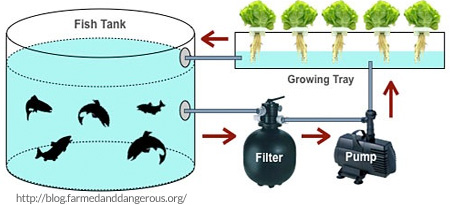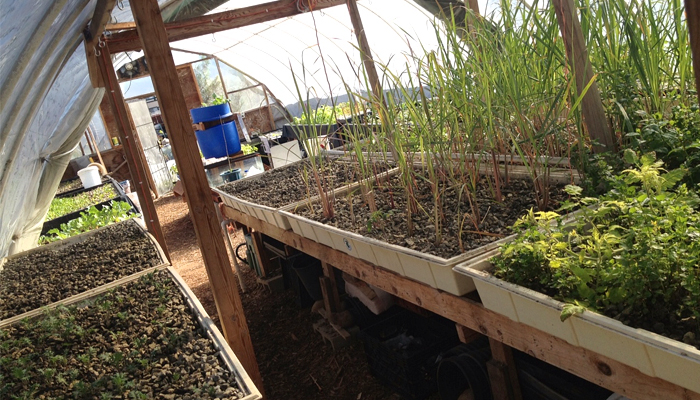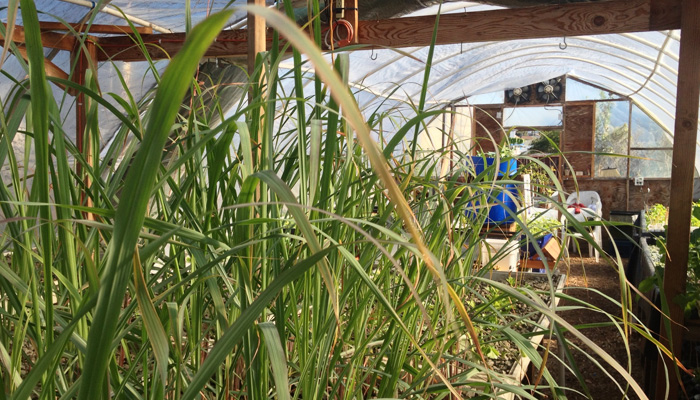
Aquaponics: Hydroponics Meets Aquafarming
A report done recently by the UK’s Institute of Mechanical Engineers (IMechE) has discovered that about 1.2-2 billion tons of the food produced in developed countries is either wasted by poor storage, bad distribution, or rigorous quality standards. The current wasteful behavior is extremely ignorant, and accounts for 30-50% of the worlds produced food. Spoiling 2 billion tons of food also means that 35% of the world’s fresh water supplies are being wasted. Modern day agriculture uses 2.7 trillion cubic meters of water a year, which amounts to about 70% of the world’s freshwater use.
“…Engineers will play a crucial role in preventing future food loss and waste by developing more and more efficient ways of growing, transporting and storing foods.” – Tim Fox, IMechE Head of Energy & Environment
Nearly 12 million hectares of the world’s drylands, a piece of land the size of the United Kingdom, are being lost to a process called desertification every year. While droughts or floods can accelerate the degradation process, often times over-cultivation, overgrazing, deforestation, and faulty irrigation systems are to blame for the desert-like conditions. Although these drylands are losing their natural agricultural capabilities due to degradation, all is not lost.
IMechE reports that just one hectare of land can provide enough rice or potato for twenty-two people a year.
What this statistic suggests, is if alternative growing techniques were to be adopted, sustainable food systems could be easily created in places where in-ground agriculture is simply impossible around the world.
Alternative Growing Technique Using Fish Waste
One particular alternative method that has gained popularity goes by the name of Aquaponics, and is a combination of two traditional food production techniques, Hydroponics & Aquaculture. The concept is based around the idea of raising fish and growing plants together in one integrated, and soil-less system. The fish and the plants form a symbiotic relationship in which the fish are providing the plants with a food source, and the plants are acting as a natural filter to cleanse the water the fish live in. When operated inside a climate-controlled greenhouse, aquaponics systems are capable of producing premium quality, organic plants and fish anywhere, during any time of the year.
How does Aquaponics work?
The key component to a thriving aquaponics system is the beneficial bacteria responsible for converting fish waste, decaying plant matter, and uneaten food into ammonia and other compounds that are consumed by the plants. This naturally occurring, nitrifying bacteria, inhabit every and all surfaces of your aquaponics system, especially the grow medium in the hydroponics system.!--startfragment-->![endif]-->!-->![endif]-->!-->![endif]-->!-->![endif]-->!-->

While more than 50% of the waste produced by fish is ammonia-based urine, the other 50% is excreted in the form of fecal matter. The waste, along with decaying plant matter and un-eaten fish food, are then converted into to ammonia as well through a process called mineralization. Next the nitrifying bacterium converts the ammonia into nitrite, and then to nitrate, which plants readily uptake as nutrients. This leaves the water safe and clean so that it may be recycled back to the aquaculture tanks.
Although aquaponics systems are made up of about seven components, the three main components are the aquaculture tanks designated to raising the fish, the hydroponics bed for growing the plants, and the controlled beneficial bacteria. In order to help you fully understand aquaponics, we will first explain it’s two counterparts; Hydroponics & Aquaculture. When you look at how the pieces work independently, it is evident that aquaponics is nothing more than simple biology working its magic in a highly controlled environment.!--endfragment-->

Aquaculture
Aquaculture(also known as aqua-farming) is the raising of aquatic animals such as fish, snails, shrimp, or crustaceans (typically for food) in a symbiotic environment. It is reported that global aquaculture operations can account for producing half of the fish, and shellfish that is consumed by humans each year. However, a natural result of aquaculture is effluent rich water resulting from either uneaten fish food, or waste products from animals being raised. This requires a large amount of solids removal as well as bio-filtration.
Over the years farmers have experimented with new sustainable practices to lessen the biological and chemical pollution caused by their animals, as well as the dumping of waste water into the earth. Some farmers have experimented with dumping the nutrient rich water over their crops, as well as adding the solid waste to their compost to treat land. This is one of the discoveries that led to the the development of aquaponics.
!--startfragment-->![endif]-->!-->![endif]-->!-->![endif]-->!-->![endif]-->!-->
Hydroponics
Hydroponics has been experimented with by The United States since the 40’s. The technique was developed at Purdue University, and worked by alternately flooding and draining a container holding gravel and the plant roots. This gave the plants a perfect balance of nutrient rich water and air. According to a 1938 Times magazine article, this technique was used during World War II in order to grow produce for large amount of people on the inhospitable Pacific Islands. While hydroponics has come a long way since then, the basics remain the same. It is a soil-less method of growing plants in which the roots are directly immersed in nutrient-rich water that is constantly being cleansed, oxygenated, and recycled back to the plant by a hydroponics pump. Plants are grown in an inert medium, such as gravel, expanded clay, or perlite, and almost any plant will grow in a hydroponics system. The system saves water costs, makes it easier to control and utilize nutrients (lower nutrition costs), and no nutrition pollution is poured into the earth like with typical farming methods.
!--startfragment-->![endif]-->!-->![endif]-->!-->![endif]-->!-->![endif]-->!-->
Combining Aquafarming and Hydroponics
When you combine the two methods, you end up with an organic, self-sustaining mini ecosystem. The only thing you have to add once the tank has developed the beneficial bacteria, is the fish food. This saves thousands of dollars in nutrient costs, and hours of time that would have been spent mixing nutrient solutions if you were using a hydroponics system.
“Since no water escapes the system, aquaponics uses about one-tenth the amount of water as conventional farming, and nutrients are used much more efficiently.“
After allowing effluents from the fish to build up in the aquaculture tanks, the water is led to the plants in the hydroponics system, where the plants filter it out as food. Once the plants have absorbed their required nutrients, the remaining water (and a nontoxic level of leftover nutrients) are re-circulated straight back to the aquaculture tanks as clean, breathable water for the fish. In addition, plants can be grown very close, allowing you to grow much higher volumes of plants per square foot. The ability to stock high densities of fish allows plants to be grown rapidly in aquaponics systems. However, like nature, aquaponics is all about balance. There are many factors that go into aquaponics, and it is definitely not an ideal growing technique for unexperienced growers.

Although Tilapia are the most popular type of fish raised in the systems (for food purposes), farmers have been known to raise anything from goldfish to large mouth bass. The number of fish that can be raised in each tank is dependent upon the size of tank, and mode of filtration you are using. In larger tanks with proper filtration, growers sometimes stock up to ½ lb of fish per gallon, while smaller aquarium grows are typically limited to one gallon per ½ inch of fish.
The number of plants you can grow in an aquaponics system is a factor of the number & size of the fish, and the amount of food added daily. Some plants like tomatoes, peppers, cucumbers, and other flowering plantshave higher nutritional demands than others, and will only thrive in a heavily stocked, time-honored system. The most popular plants grown in aquaponics include lettuce, spinach, arugula, basil, mint, watercress, chives, and most common houseplants.
Where is Aquaponics being used?
Many gardeners are building systems in their backyards, capable of producing hundreds of pounds of fish and vegetables a year. Home aquariums can even be combined with mini gardens that sit on top of the tanks in some of the simplest systems. Since these systems model biological cycles in a natural habitat, schools are building mini aquaponics systems in classrooms for educational purposes. Aquaponics is also being used commercially, but there are currently a limited number of large-scale operations. What are more prevalent are smaller operations like urban farms that are growing vegetables, fish, and herbs to sell to local restaurants and at farmers markets.
With the organic and healthy eating craze spreading like wildfire in the U.S., urban aquaponic farms are sprouting up providing ‘foodies’ everywhere with direct access to fresh and organically grown fruits, vegetables, and fish. In addition, many non profits are working to establish sustainable communities in undeveloped countries, as well as urban settings where agriculture was thought to be out of the question. The Urban Farming Guys is a public charity from inner-city Kansas dedicated to transforming entire communities into thriving and sustainable places for the next generation. They are providing everything from job creation, to healthy food directly onto plates of less fortunate community members. The Urban Farming Guys have even begun experimenting with solar powered aquaponics that would provide an alternative farming method to third world countries, where electricity is often times intermittent.
Our Visit to New Roots Aqua Farm
We visited an urban farm with a similar mission here in San Diego. The farm is located in City Heights, one of the most diverse, highly concentrated areas of retail outlets, restaurants, and supermarkets in the area. On our way to the farm we drove past concrete building after concrete building until finally, like an oasis in the desert,IRC New Roots Aqua Farm appeared on the left side of the street. The farm sat atop a concrete lot situated directly across the street from a number of ten-story high rises. In the middle of the nursery was a greenhouse containing a 1,200 square foot aquaponics system in which trays of basil, lettuce, tomatoes, and kale were thriving in extremely close quarters. One of the experienced farmers informed us that they could grow corn as close as 3″ to each other. We found this astonishing.

In addition, the farm pumps water from the tanks, out of the greenhouse to fertilize the outdoor crops. They also grew their own fish food in order to cut back on costs, and provide their fish with organic food. They explained to us that Duckweed was the perfect fish food to grow because it multiplied so quickly, and required little to no maintenance. In addition, the Duckweed tanks provide the perfect habitat for New Root’s baby fish to develop in until they can be moved to the larger tanks.
New Roots Aqua Farm harvest’s hormone-free tilapia in 700-gallon fish tanks, as well as organic vegetables and herbs which are sold at the City Heights Farmers’ Market every Saturday. The farm also has a very experienced grower onsite who offers plans for personal aquaponics systems. However, the operators of the farm explained to us that the farm’s main purpose is to provide the community access to locally grown, organic food that they would otherwise never get from city grocery stores such as Ralph’s. They also aim to provide the neighborhood’s large refugee population with an educational resource for those interested in growing their own food, as many did in their native countries.

The International Rescue Committee (IRC) is a part of San Diego’s Food Security and Community Health (FSCH) program that aims to create sustainable, locally-grown, culturally-appropriate foods for San Diego’s low-income communities. City Heights residents interested in farming are invited to use one of 80 spaces designated for families to grow their own plots in the heart of the neighborhood, at the New Roots Community Farm. It is a great way for refugee families to gain direct access to nutrition, and provide some with their first opportunity to reconnect with the land in the United States. Michelle Obama referred to the IRC’s, New Roots Community Farm as a, “model for communities around the country.”
For additional information about aquaponics as well as FAQ, please visit Aquaponics.com.
Other Helpful Links:
- http://en.wikipedia.org/wiki/Aquaponics
- http://www.rescue.org/us-program/us-san-diego-ca/irc-aqua-farm-tours#Plants
- http://www.rescue.org/us-program/us-san-diego-ca/volunteer-work-days-new-roots
- http://www.rescue.org/us-program/us-san-diego-ca/fsch
- http://theurbanfarmingguys.com/
- http://cleantechauthority.com/revolutionizing-agriculture-with-aquaponic-process/
Article Sources:
- http://www.rtcc.org/we-must-correct-image-of-desertification-and-find-practical-solutions/
- http://www.rtcc.org/colossal-food-waste-hitting-energy-land-and-water-supplies/
- http://www.imeche.org/Libraries/News/Global_Food_Waste_Not_Want_Not.sflb.ashx
- http://ezinearticles.com/?Hydroponics-Used-In-World-War-II-To-Feed-US-Troops&id=1207739
- http://aquaponics.com/page/aquaponic-systems
!--endfragment-->!--endfragment-->